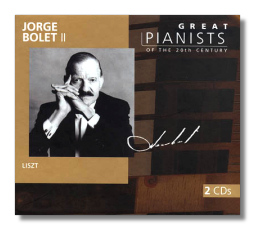
The Internet's Premier Classical Music Source
Related Links
- Latest Reviews
- More Reviews
-
By Composer
-
Collections
DVD & Blu-ray
Books
Concert Reviews
Articles/Interviews
Software
Audio
Search Amazon
Recommended Links
Site News
 CD Review
CD Review
Great Pianists of the 20th Century

Volume 94 - Rosalyn Tureck II
Johann Sebastian Bach
- Variations "Goldberg"
- Partita in B minor
- Concerto "Italian"
- Four Duets
Rosalyn Tureck, piano
Philips 456979-2 ADD 2CDs 78:36, 77:01


Volume 10 - Jorge Bolet II
Franz Liszt
- Waltz "Mephisto" #1
- Venezia e Napoli
- Funérailles
- Liebestraum #3
- La leggierezza
- La campanella
- Sonetto 104 del Petrarco
- Harmonies du soir
- Gnomenreigen
- Au bord d'un source
- Consolation #3
- Rhapsody "Hungarian" #12
- Ricordanza
- Bellini/Liszt: Réminiscences de "Norma"
- Mozart/Liszt: Réminiscences de "Don Juan"
- Verdi/Liszt: Paraphrase "Rigoletto"
Jorge Bolet, piano
Philips 456814-2 ADD/DDD 2CDs 77:54, 76:37
Philips Classics and Steinway & Sons hurtle to the end of their invaluable 200-disc Great Pianists of the 20th Century series with follow-up volumes devoted to Rosalyn Tureck and Jorge Bolet. Both pianists, incidentally, were born in 1914; Bolet died in 1990, and Tureck remains alive and kicking, as far as I know. Her volume is particularly welcome because it includes recordings that have been hard to find for decades. Although Bolet's volume contains more recent material from his last London/Decca years, it is good to have a de facto "Liszt's Greatest Hits for the Piano" selection as comprehensive as this one.
Tureck is often described as the "high priestess of Bach," a statement that might have given harpsichordist Wanda Landowska pause! Although she has played the music of many other composers, Bach was her forte from an early age, and so he has remained. She has done six commercial recordings of the Goldberg Variations alone. This one dates from 1957; it was recorded for EMI in London's Abbey Road Studio. The sound is disappointingly clattery, and many of the notes in the upper range of the keyboard suffer from discoloration or even distortion. Nevertheless, you can't keep a great performance down, and Tureck's Goldbergs rank with the very best. Her view of this music is essentially sober and faithful, to the extent that one can play Bach on a modern piano and remain faithful! She takes all the repeats, omitting nothing, and she embellishes conscientiously and with sensitivity. Tureck plays the piano as if it were a piano, not an overgrown harpsichord, and yet she can't be accused of the distortions in dynamics, tempo, and articulation that some other Bach pianists have been guilty of. If she takes any risk at all, it's the risk of seeming too rational, too insistent that no un-Bachian passions will carry her away. This is one of those Goldberg recordings that requires more than one CD; approximately 93 minutes is Tureck's total time. In the Partita in B minor (the so-called "French Overture"), as well as in the remaining works in this collection, Tureck has the benefit of better sound. (This material comes from 1959.) Again, her playing is solid, exquisitely phrased, and highly intellectual, even in the Italian Concerto, which other pianists play for its incipient high-spiritedness.
The first volume of Bolet (456 724-2) was a tour de force. Its centerpiece was the Carnegie Hall recital from 1974, and few live recordings match that one for animal excitement. Bolet, who thrived on an audience's responsivity, was a different pianist in the recording studios; still, he could be a marvel under these less stimulating conditions, as his Liszt recordings from the 1980s show. This is an excellent selection of those recordings. Bolet's Romantic-age technique allowed him to excel in Liszt's pyrotechnics. Nevertheless, he was seemingly incapable of rattling off the notes without giving them a stature usually associated with late Beethoven, for example. This effect may be due, at least in part, to the velvety perfection of his tone, and to his avoidance of sentimentality. It also may be due to the studio medium itself, where his more virtuosic impulses were reined in. Bolet makes even trifles such as the Liebestraum #3 sound profound. Is there a Liszt pianist alive today who can do what he did? The recordings, all from London/Decca originals, are first-class, and Josef Manhart's appreciation (translated from the German) is refreshingly honest.
These volumes are two more reasons to explore what might be the most fascinating recording project of the late 1990s.
Copyright © 1999, Raymond Tuttle


















